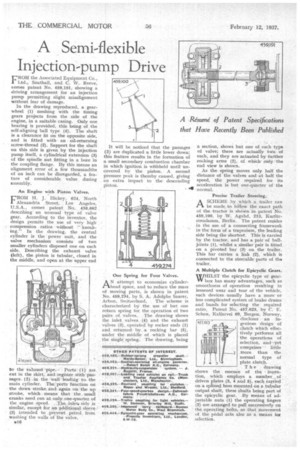A Semi-flexible Injection-pump Drive
Page 122

If you've noticed an error in this article please click here to report it so we can fix it.
FROM the Associated Equipment Co., Ltd., Southall, and C. W. Reeve, comes patent No. 459,191, showing a driving arrangement for an injection pump permitting slight misalignment without fear of damage.
In the drawing reproduced, a gearwheel (1) meshing with the timing gears projects from the side of the engine, in a suitable casing. Only one bearing is provided, this being of the self-aligning ball type (4). The shaft is a clearance fit on the opposite side, and is fitted with an oil-returning screw-thread (2). Support for the shaft on this side is given by the injection pump itself, a cylindrical extension (3) of the spindle nut fitting in a bore in the coupling flange. By this means an alignment error of a few thousandths of an inch can be disregarded, a feature of considerable value during assembly.
An Engine with Piston Valves.
E.ROM H. J. Hickey, 624, North
Alexandria Street, Los Angeles, U.S.A., comes patent No. 458,662 describing an unusual type of valve gear. According to the inventor, the design permits the use of very high compression ratios without "knocking' In the drawing, the central cylinder is the power unit, and the valve mechanism consists of two smaller cylinders disposed one on each side. Describing the exhaust valve (left), the piston is tubular, closed in the middle, and open at the upper end
to the exhaust 'pipe., Ports (1) are cut in the skirt, and register With passages (2) .in the wall leading to the main cylinder. The pofts function on the down stroke, and again on the up stroke, which means that the small cranks need run at only one-quarter of the engine speed. The side. is similar, except for an additional sleeve , (3) intended to prevent petrol from washing the walls of the valve.
1116 It will be noticed that the passages (2) are duplicated a little lower down; this feature results in the formation of a small secondary combustion chamber in which ignition is withheld until uncovered by 'the piston. A second pressure peak is thereby caused, giving an extra impact to the descending piston.
One Spring for Four Valves.
AN attempt to economize cylinderhead space, and to reduce the mass of moving parts, is shown in patent No. 459,274, by S. A. Adolphe Saurer,
Arbon, Switzerland. The scheme is characterized by the use of but one return spring for the operation of two pairs of valves. The drawing shows the inlet valves (4). and the exhaust valves (3), operated by rocker ends (1) and returned. by a rocking bar (5), udder the middle of which is placed the single spring: The drawing, being
a section, shows but one of each type of valve; there are actually two of each, and they are actuated by further rocking arms (2), of whichonly the end view is shown.
As the spring moves only half the distance of the valves and at half the speed, the power required for its acceleration is but one-quarter of the normal.
Precise Trailer Steering.
ASCHEME by which a trailer can be made to follow the exact path of the tractor is shown in patent No. 459,100, by W. Agahd, 213, Kurftirstendamm, Berlin. The patent resides in the use of a connecting framework in the form of a trapezium, the leading side being the shortest. This is carried by the tractor, and has a pair of bail-joints (1), whilst a similar pair is fitted on a pivoted bar (3) on the trailer. This bar carries a link (2), which is connected to the steerable parts of the trailer,
A Multiple Clutch for Epicydic Gears.
WHILST the opicyclic type of gearVV box has many advantages, such as smoothness of operation resulting in lessened wear and tear of the vehicle, such devices usually have a more or less complicated system of brake drums and bands for selecting the required ratio, Patent No. 457,023, by C. E. Schou, Kalfarvei 69, Bergen, Norway, discloses an in 457,0t3 genious design of 11=4".„1 clutch which effec„11:4=11" tively performs all I' 111%.' the operations of
'LC selection, and.yet comprises" little comprises" little 2 more than the normal type of
5 4 3 plate clutch.
T h e drawing shows the essence of the invert. tion, which employs a number,, of driven plates (3, 4 and 5), each carried on a splined boss mounted on a tubular output shaft, these shafts being' part of the epicyclic gear. By means of adjustable nuts (1) the operating fingers (2) are arranged to pull successively on the operating bolts, so that movement of the pedal acts also as a means for selection.




























































































































































